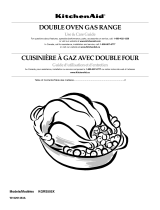
14
Keep Warm™ Feature
IMPORTANT: Food must be at serving temperature before placing
it in the warmed oven. Food may be held up to 1 hour; however,
breads and casseroles may become too dry if left in the oven
during the Keep Warm™ function. For best results, cover food.
The Keep Warm™ feature allows hot cooked foods to stay at
serving temperature.
To Use:
1. Press the KEEP WARM keypad for the desired oven.
“KEEP WARM” will scroll in the upper or lower text area
(depending on oven selection), and “170°F (77°C)” will be
displayed.
“Set temp or” will scroll in the selected oven text area, followed
by “Push START.”
2. Press the Temp/Time “+” or “-” pads to adjust the temperature
by 5°F (3°C) increments until the desired temperature is
displayed.
The temperature can be set from 145°F (63°C) to 190°F (85°C).
NOTE: The temperature may be changed at any time by
pressing the Temp/Time “+” or “-” pads until the desired
temperature is displayed and then START.
3. Press START.
“Keeping Warm” will appear in the selected oven text area, and
the set temperature will be displayed.
4. “KEEPING WARM” and the temperature will be displayed while
the Keep Warm setting is active.
5. Place food in the oven.
6. Press CANCEL for the desired oven when finished.
7. Remove food from the oven.
To Cancel Keep Warm™ Feature:
Press CANCEL for the desired oven. Remove food from oven.
Sabbath Mode
The Sabbath Mode allows the range to operate in compliance with
the Star-K Jewish Sabbath requirements for a Bake cycle,
including Timed Bake or Delayed Bake functions. To use the
Sabbath Mode on this range note the following:
■ The Sabbath Mode feature must first be enabled. This is done
only one time and only if Sabbath Mode is expected to be used
at a later time.
■ When Sabbath Mode is enabled all range features and
functions operate the same as before Sabbath Mode was
enabled.
■ When Sabbath Mode is enabled and activated it can be used
for any Bake, Timed Bake or Delayed Bake cycle by completing
the steps in “To Activate Sabbath Mode” in this section.
When Sabbath Mode is activated your range will run under the
following conditions:
■ All cooking functions are disabled except for Bake, Timed Bake
and Delayed Bake.
■ The following keypads can be used: Bake, Cancel, Start,
Kitchen Timer and the Temp/Time “+” and “-” arrows.
■ The following features are disabled and cannot be used: all
tones and chimes; timers; 12 Hour Shutoff; Oven Cleaning and
Energy Save.
■ Cooktop burners can be used.
■ The oven light will not change and will remain on or off all the
time, even if the Oven Light keypad is pressed or the oven
doors are opened or closed.
■ For best results, cooking should be done on one rack in the
upper oven and one rack in the lower oven.
To Enable Sabbath Mode (one time only):
Sabbath Mode must be enabled to allow the control to activate a
Bake, Timed Bake or Delayed Bake under the conditions listed
previously.
1. Press SETTINGS eight times until “SABBATH” appears in the
upper text area.
2. Press the Temp/Time “+” arrow pad to enable Sabbath Mode.
“ON Selected” scrolls twice in the upper text area. The oven is
now enabled to be run in Sabbath Mode.
3. Press CANCEL to exit. Sabbath Mode remains enabled.
NOTE: To disable the Sabbath Mode, repeat the previous steps
1-3. “Sabbath OFF” should scroll in the display.
To Activate Sabbath Mode:
Sabbath Mode can be activated for a Bake, Timed Bake or Delayed
Bake if Sabbath Mode has been enabled.
1. Start a Bake, Timed Bake or Delayed Bake.
2. If Sabbath Mode is to be used for both ovens, start a Bake,
Timed Bake or Delayed Bake in the second oven.
3. Press and hold KITCHEN TIMER for 5 seconds. “Sabbath-
Bake” appears in the upper text area for 3 seconds.
For a Timed Bake function, the time will also be displayed.
To Adjust Temperature (when Sabbath Mode is running in only
one oven):
1. Press the Temp/Time “+” or “-” arrow pads. Each press of the
pads will increase or decrease temperature by 25°F (14°C). No
temperature change will appear in the display.
2. Press and hold START longer than 1 second to set the
temperature change. No temperature change will appear in the
display.
To Adjust Temperature (when Sabbath Mode is running in both
ovens):
1. Press BAKE for the desired oven.
2. Press the Temp/Time “+” or “-” arrow pads. Each press of the
pads will increase or decrease temperature by 25°F (14°C). No
temperature change will appear in the display.
3. Press and hold START longer than 1 second to set the
temperature change. No temperature change will appear in the
display.
To Deactivate Sabbath Mode:
Sabbath Mode can be deactivated at any time during an active
Sabbath Mode.
1. Press and hold KITCHEN TIMER for 5 seconds to return to
regular baking or press CANCEL to turn off the oven(s).
If a Power Failure Occurs During Sabbath Mode
If a power failure occurs during Sabbath Mode, and the upper text
area displays “Sabbath,” press the Upper Oven or Lower Oven
CANCEL to exit Sabbath Mode. The display will show the time of
day. Sabbath Mode is no longer active, but it is still enabled for the
range.
WARNING
Food Poisoning Hazard
Do not let food sit in oven more than one hour before
or after cooking.
Doing so can result in food poisoning or sickness.




















